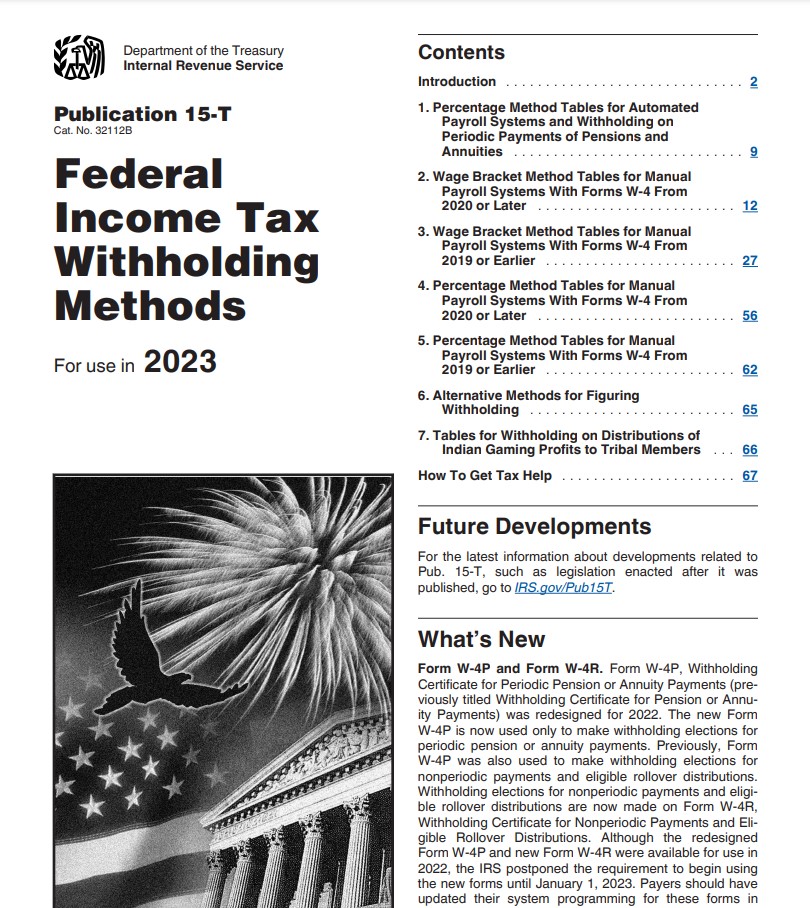Table of Contents
Federal Withholding Tables 2023 – The federal government will implement new tax withholding tables. These withholding tables are used by taxpayers to calculate their estimated tax payments throughout the year and can help determine how much they should withhold from each paycheck. Taxpayers need to understand how the new withholding tables work to ensure they’re not overpaying or underpaying their taxes. The Internal Revenue Service (IRS) is responsible for providing these tables and has recently released information about the changes that will be seen in 2023.
New Article: W4 Form 2025.
The new withholding tables have been designed to simplify the calculation of estimated taxes, which can often be difficult for individuals who don’t have a strong understanding of tax law.
What is the Federal Income Tax Withholding?
Federal income tax withholding is an important part of the US taxation system. Employers must withhold a portion of employees’ wages annually to cover their eventual tax liability. This money is then sent to the Internal Revenue Service (IRS) with the employee’s annual return. The IRS will release new withholding tables for both regular and supplemental wages, allowing employers and employees to know exactly how much should be withheld from each paycheck.
The latest withholding tables for 2023 will be based on changes made in recent years to both personal exemptions and standard deductions under the Tax Cuts and Jobs Act (TCJA). The primary purpose of these updated tables is to ensure that taxpayers have enough money taken out of their paychecks throughout the year so they do not owe a large amount at tax time.
Federal Income Tax Withholding Methods 2023 – Publication 15-T
Federal income tax withholding methods provide employers with information on adjusting their withholding payments so that employees are not over or under-withheld. It includes new tables for calculating the amount of taxes to withhold from employee wages and salaries and updated rules for calculating credits and deductions. The tables are based on an employee’s filing status, the number of allowances they claim, and annual salary or wages.
In addition to providing detailed instructions on how to use the new tables, Publication 15-T also outlines changes made to existing tax credits and deductions. These include changes related to itemized deductions and dependent exemptions. Employers should ensure that they understand how these updated rules impact their payroll processes to accurately calculate their employees’ taxes.
Federal Withholding Tables are documents issued by the Internal Revenue Service (IRS) that contain information about how much to withhold from an employee’s paycheck for tax purposes. Publication 15-T is one of these documents and is updated annually. The latest version, Pub. 15-T for 2022 has been released and is available for download here on the link. Unfortunately, the IRS has yet to issue a Publication 15-T for 2023, leaving employers without guidance on their withholding responsibilities for the new year.
The absence of this important document can create problems for employers who will be required to follow it when calculating federal taxes from employees’ salaries in 2023. There may also be confusion among employees when they see changes in their paychecks due to discrepancies between what their employer deducts and what they should receive, according to the tables.
UPDATE:
- You can download Federal Withholding Tables 2023 – Pub 15-T 2023 HERE.
Who Uses Withholding Tables?
The Federal Withholding Tables are a tool employers use to calculate the correct amount of taxes to be withheld from employee wages. They are based on income, marital status, and the number of withholding allowances an employee has claimed. Everyone who files taxes in the U.S. must use these tables to ensure they are paying the right amount of taxes throughout the year and at tax time.
Using these tables, employers use the information gathered from their employees’ W-4 forms, such as filing status and the number of allowances, to determine how much should be withheld from their paychecks every month. Taxpayers can also find out their monthly withholding to ensure it is accurate on their monthly paystubs.
Calculating Federal Income Tax Withholding
Calculating federal income tax withholding can be complicated and intimidating for employees. The IRS sets forth guidelines to help employers estimate their staff’s wages and tax withholdings with federal withholding tables. Employers must use these tables when calculating the amount withheld from employees’ wages, ensuring individuals are paying their fair share of the annual tax liability.
The tables provide wage categories based on filing status, such as single or married, and frequency of pay periods. The data from these charts determine the total amount that should be deducted from each paycheck for Social Security, Medicare, and federal income taxes. To ensure accuracy in calculations and deductions, employers and employees must understand how to use these tables correctly.
Comparing Withholding Tables to W-4 Forms
The Internal Revenue Service (IRS) has different options for employers when calculating withholding taxes from employee paychecks. Federal Withholding Tables are one option, and W-4 Forms are another. Employers must understand the differences between these two options to ensure that their employees’ withholdings are accurate and compliant with federal regulations.
Federal Withholding Tables contain a set of predetermined tax schedules that employers use to calculate the amount of tax to be withheld from an employee’s paycheck based on their filing status and total income. This method is straightforward, but there is not much flexibility or customization available if an employee’s situation requires additional adjustments.
